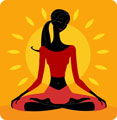What I Learnt In 2006
1. Your first three gurus should be your body, mind and soul.
2. You don't teach to be patted on the back. But the pats will come if you teach with your heart. And to grow, you will have to forget that your back was ever patted.
3. Being present is half the battle won.
4. There will always be students who are better than you. You must not be intimidated or envious of them. Instead, delight in the beauty of their asanas. Likewise, there will always be teachers who are not as good as you. You must neither scorn nor pity them. Instead, respect their individual rhythm of growth.
5. If you hesitate before attempting a challenging asana, it’s not your body that is holding you back, but your ego.
6. Satya (telling the truth) clears the mind and heart of toxicity.
7. You must follow your dharma (destiny) even if it means going against the grain. There is no reason to be afraid for a Higher Power is always guiding you.
8. The practice of pranayama (breathing) is more challenging than that of sirsasana (headstand).
9. If you falter, there is no shame in starting over.
10. True yoga cannot be practiced. It must be lived.
1. Your first three gurus should be your body, mind and soul.
2. You don't teach to be patted on the back. But the pats will come if you teach with your heart. And to grow, you will have to forget that your back was ever patted.
3. Being present is half the battle won.
4. There will always be students who are better than you. You must not be intimidated or envious of them. Instead, delight in the beauty of their asanas. Likewise, there will always be teachers who are not as good as you. You must neither scorn nor pity them. Instead, respect their individual rhythm of growth.
5. If you hesitate before attempting a challenging asana, it’s not your body that is holding you back, but your ego.
6. Satya (telling the truth) clears the mind and heart of toxicity.
7. You must follow your dharma (destiny) even if it means going against the grain. There is no reason to be afraid for a Higher Power is always guiding you.
8. The practice of pranayama (breathing) is more challenging than that of sirsasana (headstand).
9. If you falter, there is no shame in starting over.
10. True yoga cannot be practiced. It must be lived.


